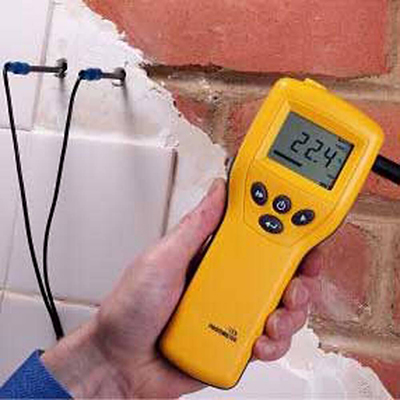Moisture in walls is a common concern for property owners, whether you’re buying, selling, or maintaining your home. High moisture content can lead to structural damage, mould growth, and a decrease in property value, but not all moisture is a problem. Understanding what are the normal moisture levels in walls is essential for identifying issues early and protecting your investment.
At Surveying Cymru, our team of Chartered Surveyors helps homeowners across South Wales, Gloucestershire, and Herefordshire assess and manage moisture in their properties. Using industry-standard methods and specialist equipment, we provide clear, reliable reports that help you take informed action.

Understanding Moisture Levels in Walls
Why Moisture Levels Matter in Property Care
All building materials contain some level of moisture, it’s a natural part of the construction process and environment. Problems arise when moisture levels rise above the normal range, leading to dampness, structural decay, and health risks from mould spores.
Monitoring moisture levels is key for:
- Detecting damp problems before they worsen
- Planning remedial work effectively
- Maintaining a healthy living environment
Common Causes of Elevated Moisture
- Water Ingress: Rainwater entering through defective roofing, gutters, or external walls
- Plumbing Leaks: Burst or leaking pipes hidden within walls or floors
- Condensation: Caused by poor ventilation and high indoor humidity
- Rising Damp: Groundwater travelling up through walls because of failed damp-proof courses.
What Is Considered a Normal Moisture Level in Walls?
Industry Standards and Acceptable Readings
For most internal walls in established properties, moisture content should ideally be below 15%. Readings between 15% and 20% may indicate a potential problem and should be monitored, while anything above 20% generally warrants further investigation.
How Moisture Levels Are Measured
We use calibrated moisture meters to measure moisture content either as a percentage of the material’s dry weight or as a relative scale reading.
Two common methods are:
- Pin-type meters: Measure resistance between two pins inserted into the surface
- Pinless meters: Use electromagnetic signals to detect moisture deeper within the wall
Differences Between New and Older Properties
New builds and recently plastered walls can naturally hold higher moisture readings until they have fully dried, which may take several months. Older properties, especially those without modern damp-proofing, may show slightly higher baseline levels due to their construction methods.
Risks of High Moisture Content in Walls
Structural Damage Over Time
Excess moisture can weaken plaster, mortar, and timber supports, leading to costly structural repairs.
Mould Growth and Health Implications
Persistent damp creates the perfect environment for mould, which can aggravate allergies, asthma, and other respiratory conditions.
Impact on Property Value
Signs of dampness can deter buyers and reduce the market value of your property, making early detection and resolution essential.
How Chartered Surveyors Assess Moisture Levels
Moisture Meters and Diagnostic Tools
At Surveying Cymru, we use high-quality professional equipment, including:
- Electronic moisture meters for precise readings
- Thermal imaging cameras to detect temperature differences linked to damp
- Hygrometers to measure humidity levels in the air
Interpreting Readings Accurately
A key part of our role as Chartered Surveyors is interpreting results correctly. Moisture readings alone can’t always confirm a damp problem — we consider the building’s age, construction, recent weather conditions, and any visual signs of damage.
Identifying the Source of the Problem
We investigate potential sources, such as defective pointing, roof leaks, faulty plumbing, or poor ventilation. This ensures any remedial action targets the root cause rather than just the symptoms.
Preventing and Managing Damp Problems
Addressing External Water Ingress
- Repair damaged roof tiles and guttering
- Repoint brickwork and seal cracks in render
- Install or repair damp-proof courses
Improving Ventilation and Airflow
- Fit extractor fans in kitchens and bathrooms
- Keep windows open where possible to allow airflow
- Avoid drying clothes indoors without adequate ventilation
Ongoing Maintenance and Monitoring
- Schedule periodic property inspections
- Check for leaks around pipes and appliances
- Re-measure moisture levels annually, especially in problem-prone areas
Why Choose Surveying Cymru for Damp and Moisture Inspections
Local Expertise Across South Wales, Gloucestershire, and Herefordshire
We understand the unique building styles, materials, and climate-related challenges in our region, enabling us to provide tailored, effective solutions.
Fully Qualified Chartered Surveyors
Our RICS accreditation ensures we meet the highest professional and technical standards, delivering accurate and impartial reports every time.
Clear, Actionable Reports You Can Rely On
We don’t just give you numbers, we explain what they mean for your property and recommend practical next steps.
Frequently Asked Questions
Moisture content below 15% is typically considered normal. Levels above 20% usually indicate a problem that should be investigated.
We use specialist tools such as pin-type and pinless moisture meters, supported by thermal imaging and humidity measurements.
Yes. Fresh plaster or recently built walls may have higher moisture levels until they fully dry, which can take several months.
Arrange a professional damp survey to identify the source of moisture and take corrective action before damage worsens.
Yes. Our reports include detailed readings, photographs, and expert recommendations, suitable for insurance claims and mortgage applications.
Book a Moisture Inspection with Surveying Cymru Today
If you are concerned about dampness or want to check the moisture levels in your walls, our team can help. With clear, professional advice and accurate testing, we give you the knowledge to protect your home or investment.
Call: 01600 715350 Email: nick@surveyingcymru.co.uk